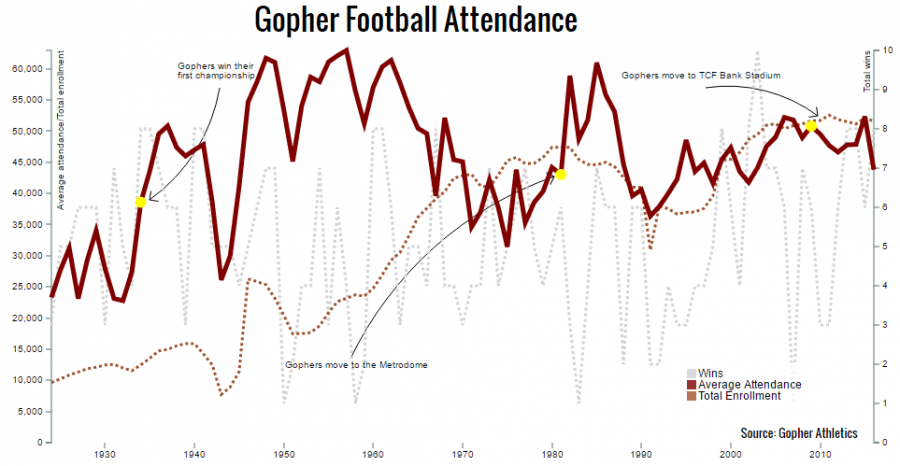Average announced attendance at Gopher football games fell sharply after near-record numbers.
Reported numbers show that average turnout was down about 8,500 per game after hitting 52,000 last year — a 30-year high. University Athletics Department officals and coaches say this year’s victory record and bowl appearance could help boost ticket sales in the future.
“You can try all of the gimmicks, you can do all you want,” said Gophers football head coach Tracy Claeys at a recent press conference. “The only way to improve the attendance, you got to win.”
Still, a Minnesota Daily analysis of attendance data showed that there is only a slight correlation between victories and how many seats are filled.
The largest average crowd the Gophers have seen was in 1957, when attendance per game was about 63,000. That was when the team played at the now-demolished Memorial Stadium, which could expand to a capacity of 66,000 with temporary bleachers.
TCF Bank Stadium seats around 51,000, but can hold more people with standing room only tickets. Therefore, it’s no wonder attendance hasn’t cracked 60,000 since 1985, when the team played at the now-demolished Metrodome. The gophers finished 7-5 that year.
The Gophers have seen a few huge bumps in their history, like after the end of World War II and when they moved to the Metrodome in 1981.
Attendance didn’t climb nearly as much when they moved to TCF Bank Stadium in 2009.
But even taking into account the reduced capacity, Gopher football attendance lagged in the Big Ten this year. Ohio State University’s and the University of Michigan’s average attendance at home games was greater than their stadiums’ reported capacity. The University of Wisconsin Madison’s average was 98.5 percent of its 80,321 person capacity.
At 86 percent, Minnesota fell behind the Big Ten’s top teams.
“It’s on us to earn people back. I promise you as we enter the offseason after the bowl game, we look very hard at what’s working, what’s not working, what can we do to improve the fan experience,” said Athletics Director Mark Coyle.
To help boost sagging ticket sales, Coyle froze a scheduled cost increase for some tickets earlier this fall.
“With an eight-win season, a chance to play a Power Five program like Washington State in the Power-5 conference is a great opportunity for us to continue to build that momentum for next year and move forward,” Coyle said.
Mike Hendrickson contributed to this report.








